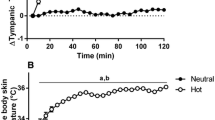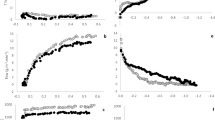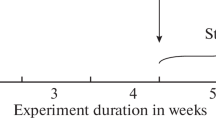Abstract
The effects of two interventions, high ambient temperature, a sympathetic activator, and clonidine, a centrally acting sympatholytic drug, were compared on a number of autonomic functions. Eight healthy male volunteers participated in four weekly sessions. Each session was associated with one of the following treatments: placebo (physiological saline infused intravenously over 10 min) at 20°C; clonidine hydrochloride (1.5 μg kg-1 in 10 ml infused intravenously over 10 min) at 20°C; placebo at 40°C; clonidine at 40°C. Subjects were allocated to treatments and sessions according to a double-blind (for drug condition) balanced design. In each session, the following indices of autonomic function were recorded: systolic and diastolic blood pressure, heart rate, salivation, body temperature, plasma noradrenaline and adrenaline concentrations, baseline and carbachol-evoked sweating, physiological finger tremor. Raised ambient temperature (40°C) caused increases in heart rate, body temperature, carbachol-evoked sweating and physiological finger tremor. Clonidine (at 20°C) reduced systolic blood pressure, body temperature, salivation and plasma noradrenaline concentration, but did not affect any of the other measures. Clonidine (at 40°C) counteracted the increase in heart rate, but not the increases in carbachol-evoked sweating and finger tremor, evoked by high ambient temperature. The high ambient temperature condition abolished the body-temperature-lowering effect of clonidine, but did not modify the effects of clonidine on systolic blood pressure, salivation and plasma noradrenaline concentration. These results indicate that while the effects of the heat stressor are consistent with an increase in sympathetic activity, and most of the effects of clonidine are consistent with a decrease in sympathetic activity, only two functions (body temperature and heart rate) were affected in opposite directions by the two interventions. Indeed, physiological antagonism between the two interventions could be demonstrated on body temperature and heart rate only, and there was no evidence for an interaction between the effects of the two variables on any of the other indices of autonomic activity. The failure of clonidine to affect two sympathetically mediated functions, carbachol-evoked sweating and physiological finger tremor, under either temperature condition, indicates that central α2-adrenoceptors cannot be involved in the regulation of these functions.
Similar content being viewed by others
Author information
Authors and Affiliations
Additional information
Received: 28 June 1996 / Accepted: 22 November 1996
Rights and permissions
About this article
Cite this article
Arya, D., Langley, R., Szabadi, E. et al. Comparison of the effects of high ambient temperature and clonidine on autonomic functions in man. Naunyn-Schmiedeberg's Arch Pharmacol 355, 376–383 (1997). https://doi.org/10.1007/PL00004957
Issue Date:
DOI: https://doi.org/10.1007/PL00004957




